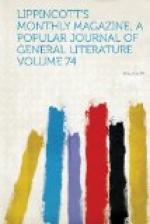surround and shut it in on either side, making it
close and sombre, and the noises of the great city
all about it penetrate here only as a far-away murmur.
There is a plat of verdant turf in the centre, bordered
by scant flowers and damp gravelled walks, along which
shrubs of evergreen and laurel are irregularly disposed.
A few seats are placed here and there within the shade,
where, as in Miss Bronte’s time, the externals
eat the luncheon brought with them to the school;
and overlooking it all stand the great old pear-trees,
whose gnarled and deformed trunks are relics of the
time of the hospital and convent. Beyond these
and along the gray wall which bounds the farther side
of the enclosure is the sheltered walk which was Miss
Bronte’s favorite retreat,—the “allee
defendue” of her novels. It is screened
by shrubs and perfumed by flowers, and, being secure
from the intrusion of pupils, we could well believe
that Charlotte and her heroine found here restful
seclusion. The coolness and quiet and—more
than all—the throng of vivid associations
which fill the place tempted us to linger. The
garden is not a spacious nor even a pretty one, and
yet it seemed to us singularly pleasing and familiar,—as
if we were revisiting it after an absence. Seated
upon a rustic bench close at hand, possibly the very
one which Lucy Snowe had cleansed and “reclaimed
from fungi and mould,” how the memories came
surging up into our minds! How often in the summer
twilight poor Charlotte had lingered here in restful
solitude after the day’s burdens and trials
with “stupid and impertinent” pupils!
How often, with weary feet and a dreary heart, she
had paced this secluded walk and thought, with longing
almost insupportable, of the dear ones in far-away
Haworth parsonage! In this sheltered corner her
other self—Lucy Snowe—sat and
listened to the distant chimes and thought forbidden
thoughts and cherished impossible hopes. Here
she met and talked with Dr. John. Deep beneath
this “Methuselah of a pear-tree,” the
one nearest the end of the alley, lies the imprisoned
dust of the poor young nun who was buried alive ages
ago for some sin against her vow, and whose perambulating
ghost so disquieted poor Lucy. At the root of
this same tree one miserable night Lucy buried her
precious letters, and “meant also to bury a
grief” and her great affection for Dr. John.
Here she had leant her brow against Methuselah’s
knotty trunk and uttered to herself those brave words
of renunciation which must have wrung her heart:
“Good-night, Dr. John; you are good, you are
beautiful, but you are not mine. Good-night,
and God bless you!” Here she held pleasant converse
with M. Paul, and with him, spell-bound, saw the ghost
of the nun descend from the leafy shadows overhead
and, sweeping close past their wondering faces, disappear
behind yonder screen of shrubbery into the darkness
of the summer night. By that tall tree next the
class-rooms the ghost was wont to ascend to meet its




